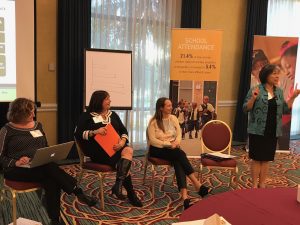“This is an incredible watershed moment,” declared Hedy Chang, Executive Director of Attendance Works at the 2017 Campaign for Grade-Level Reading (GLR) State Leads meeting. This annual gathering, held on November 13 in Orlando, FL., creates opportunities for leaders to exchange ideas on advancing the work of ensuring that children read at grade level by the end of third grade. 
The Campaign is a collaborative effort by foundations, nonprofit partners, business leaders, government agencies, states and communities across the nation to ensure that more children in low-income families succeed in school and graduate prepared for college, a career, and active citizenship. The Campaign advocates for community solutions to barriers that keep students from succeeding, such as absenteeism.
Chang moderated a panel describing strategic opportunities for GLR state leaders and local GLR campaigns to leverage the implementation of Every Student Succeeds Act (ESSA) plans in states to foster strategies to identify comprehensive systemic solutions to absenteeism. At this pivotal moment, states and communities have the opportunity to leverage the changes in federal law to address chronic absence. As this report from FutureEd shows, thirty-six states and the District of Columbia have adopted measuring attendance as part of their school quality indicator for their state accountability rubric.
The panel highlighted efforts by the Arkansas Campaign for Grade Level Reading and Strategies for Children to advance the work to reduce chronic absenteeism. Sue Fothergill, Associate Director for Policy at Attendance Works also discussed the opportunities for states to take action.
The speakers focused on the key steps they have taken to engage state leaders – including state departments of education, children’s cabinets, and campaign communities— to work collectively and create momentum behind the recognition that to improve outcomes for students, barriers to attendance must be addressed.
“The good news is that the state is very willing to work with us,” said Angela Duran, Campaign Director of the Arkansas Campaign for Grade-Level Reading. “Our state seems to be doing a very good job breaking down the silos. Chronic absence is not something to the side but a necessary precondition to achieving education goals.”
The speakers focused on steps they have already taken to reduce absenteeism including making chronic absence data publicly available, encouraging a shift in how absenteeism is tracked and monitored from a compliance framework to one that recognizes that absenteeism is lost ininstructional time.
Action steps also included identifying bright spot schools and communities that are making a difference, developing a comprehensive system of resources and technical assistance, and learning from the work of local partners to highlight policies and practices that enable a more effective response to reducing absenteeism.
Chang shared Attendance Works’ latest report, Portraits of Change, which provides a road map for state leaders to follow when developing their state strategies. The report also highlights a plethora of examples of communities across the country who are successfully reducing chronic absenteeism by taking a comprehensive multi-tiered approach to reducing absenteeism.
Want to Learn More?
Find tools for monitoring, understanding, and addressing chronic absence, beginning in the early grades through secondary school, in Resources.
Learn what individual stakeholders can do to address chronic absence in Take Action .